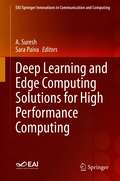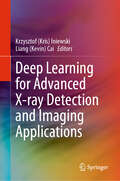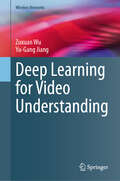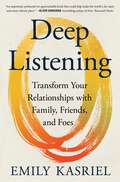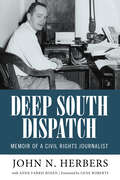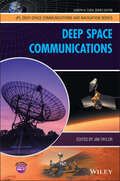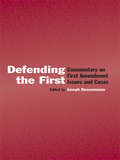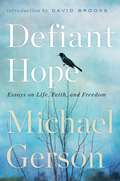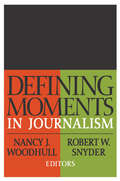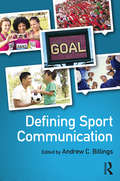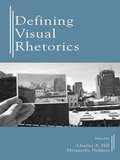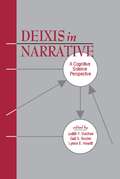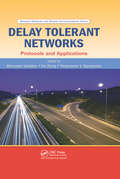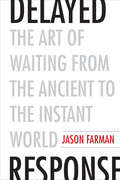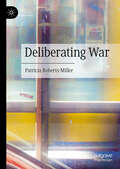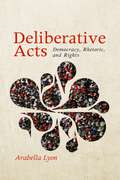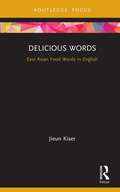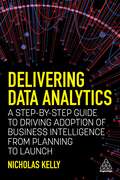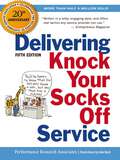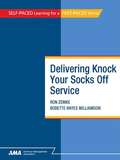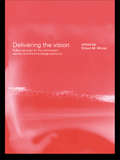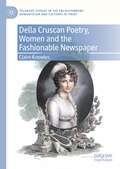- Table View
- List View
Deep Learning and Edge Computing Solutions for High Performance Computing: High Performance Computing And Emerging Healthcare Technologies (EAI/Springer Innovations in Communication and Computing)
by A. Suresh Sara PaivaThis book provides an insight into ways of inculcating the need for applying mobile edge data analytics in bioinformatics and medicine. The book is a comprehensive reference that provides an overview of the current state of medical treatments and systems and offers emerging solutions for a more personalized approach to the healthcare field. Topics include deep learning methods for applications in object detection and identification, object tracking, human action recognition, and cross-modal and multimodal data analysis. High performance computing systems for applications in healthcare are also discussed. The contributors also include information on microarray data analysis, sequence analysis, genomics based analytics, disease network analysis, and techniques for big data Analytics and health information technology.
Deep Learning for Advanced X-ray Detection and Imaging Applications
by Krzysztof Kris Iniewski Liang Kevin CaiThis book provides a comprehensive overview of the latest advances in applying Artificial Intelligence (AI) to advanced X-ray imaging, with a particular focus on its medical applications. Readers will discover why AI is set to revolutionize traditional signal processing and image reconstruction with vastly improved performance. The authors illustrate how Machine Learning (ML) and Deep Learning (DL) significantly advance X-ray detection analysis, image reconstruction, and other crucial steps. This book also reveals how these technologies enable photon counting detector-based X-ray Computed Tomography (CT), which has the potential not only to improve current CT images but also enable new clinical applications, such as providing higher spatial resolution, better soft tissue contrast, K-edge imaging, and simultaneous multi-contrast agent imaging.
Deep Learning for Video Understanding (Wireless Networks)
by Zuxuan Wu Yu-Gang JiangThis book presents deep learning techniques for video understanding. For deep learning basics, the authors cover machine learning pipelines and notations, 2D and 3D Convolutional Neural Networks for spatial and temporal feature learning. For action recognition, the authors introduce classical frameworks for image classification, and then elaborate both image-based and clip-based 2D/3D CNN networks for action recognition. For action detection, the authors elaborate sliding windows, proposal-based detection methods, single stage and two stage approaches, spatial and temporal action localization, followed by datasets introduction. For video captioning, the authors present language-based models and how to perform sequence to sequence learning for video captioning. For unsupervised feature learning, the authors discuss the necessity of shifting from supervised learning to unsupervised learning and then introduce how to design better surrogate training tasks to learn video representations. Finally, the book introduces recent self-training pipelines like contrastive learning and masked image/video modeling with transformers. The book provides promising directions, with an aim to promote future research outcomes in the field of video understanding with deep learning.
Deep Listening: Transform Your Relationships with Family, Friends, and Foes
by Emily Kasriel“If you’ve ever felt like two ears aren’t enough, this book is for you. Deep Listening reveals how we can improve at hearing others—and helping them hear us too.” —Adam Grant, #1 New York Times bestselling author of Think Again and Hidden Potential, and host of the podcast Re:ThinkingWhy do so many conversations leave us feeling unheard and disconnected? In Deep Listening, acclaimed BBC journalist, accredited executive coach, and mediator Emily Kasriel argues that it’s because we've forgotten how to truly listen.Distracted by our own agenda, we so often hear without understanding, impatiently waiting for our turn to speak. In this exploration of transformational listening, Kasriel shows how shifting from surface-level exchanges to Deep Listening can enrich our relationships as friends, parents, and partners, enhance our effectiveness as leaders, and strengthen the fabric of our communities. At a time when divisions within communities, organizations, and families are often a source of profound pain, this book offers inspiration and practical guidance on how we can better listen to each other, even when we fiercely disagree.Drawing on scientific studies, new research, and powerful stories from legendary listeners in politics, business, and the arts, Kasriel unveils her simple yet transformative eight-step approach. With Deep Listening as your guide, you’ll learn to become a better family member, friend, co-worker and citizen.At once a practical guide and a heartfelt manifesto, this groundbreaking book challenges us to rethink our approach to listening and in doing so, transform our lives from the inside out. Whether readers seek to strengthen their empathy, boost their performance at work, or foster genuine understanding across cultural, political, and generational divides, Deep Listening provides the tools and inspiration to unlock the power of lasting, meaningful connections.
Deep South Dispatch: Memoir of a Civil Rights Journalist (Willie Morris Books in Memoir and Biography)
by John N. HerbersFormer New York Times correspondent John N. Herbers (1923-2017), who covered the civil rights movement for more than a decade, has produced Deep South Dispatch: Memoir of a Civil Rights Journalist, a compelling story of national and historical significance. Born in the South during a time of entrenched racial segregation, Herbers witnessed a succession of landmark civil rights uprisings that rocked the country, the world, and his own conscience. Herbers's retrospective is a timely and critical illumination on America's current racial dilemmas and ongoing quest for justice.Herbers's reporting began in 1951, when he covered the brutal execution of Willie McGee, a black man convicted for the rape of a white housewife, and the 1955 trial for the murder of Emmett Till, a black teenager killed for allegedly whistling at a white woman. With immediacy and first-hand detail, Herbers describes the assassination of John F. Kennedy; the death of four black girls in the Birmingham, Alabama, church bombing; extensive travels and interviews with Martin Luther King Jr.; Ku Klux Klan cross-burning rallies and private meetings; the Freedom Summer murders in Philadelphia, Mississippi; and marches and riots in St. Augustine, Florida, and Selma, Alabama, that led to passage of national civil rights legislation.This account is also a personal journey as Herbers witnessed the movement with the conflicted eyes of a man dedicated to his southern heritage but who also rejected the prescribed laws and mores of a prejudiced society. His story provides a complex understanding of how the southern status quo, in which the white establishment benefited at the expense of African Americans, was transformed by a national outcry for justice.
Deep Space Communications
by Jim TaylorA collection of some of the Jet Propulsion Laboratory's space missions selected to represent the planetary communications designs for a progression of various types of missions The text uses a case study approach to show the communications link performance resulting from the planetary communications design developed by the Jet Propulsion Laboratory (JPL). This is accomplished through the description of the design and performance of six representative planetary missions. These six cases illustrate progression through time of the communications system's capabilities and performance from 1970s technology to the most recent missions. The six missions discussed in this book span the Voyager for fly-bys in the 1970s, Galileo for orbiters in the 1980s, Deep Space 1 for the 1990s, Mars Reconnaissance Orbiter (MRO) for planetary orbiters, Mars Exploration Rover (MER) for planetary rovers in the 2000s, and the MSL rover in the 2010s. Deep Space Communications: Provides an overview of the Deep Space Network and its capabilities Examines case studies to illustrate the progression of system design and performance from mission to mission and provides a broad overview of the missions systems described Discusses actual flight mission telecom performance of each system Deep Space Communications serves as a reference for scientists and engineers interested in communications systems for deep-space telecommunications link analysis and design control. Jim Taylor is a principal engineer at JPL, working on telecommunications analysis, ground-system implementation, and flight operations for deep-space and Earth-orbiting projects. He was the founding telecommunications member of JPL's Spaceflight Significant Events Group, now called Lessons Learned. He received the NASA Exceptional Achievement Medal in 2000 for innovative use of the DS1 communications systems and the NASA Exceptional Service Medal in 2006 for operational development and support on Deep Impact.
Defending Baltimore Against Enemy Attack: A Boyhood Year During World War II
by Charles OsgoodFrom beloved broadcaster Charles Osgood, a poignant memoir about one unforgettable childhood year during World War II. Defending Baltimore Against Enemy Attack is a gloriously funny and nostalgic slice of American life and a moving look at World War II from the perspective of a child far away from the fighting, but very conscious of the reverberations. With a sharp eye for details, Osgood captures the texture of life in a bygone era.
Defending the First: Commentary on First Amendment Issues and Cases (Routledge Communication Series)
by Joseph RussomannoDefending the First provides a collection of new perspectives on the First Amendment in legal and communication contexts. Editor Joseph Russomanno brings together a roster of major figures who have participated in the shaping of First Amendment law over the past 30 years. Readers are taken into a realm of personal experience and analysis through the stories of these attorneys at the forefront of the battle to defend the "First." The contributors to this volume--all of whom have argued cases before the Supreme Court--tell about their experiences appearing before the highest court in the United States. Some write many years after being there, while others offer insights from a more recent vantage point. One Supreme Court Attorney offers a historical analysis of a case replete with a variety of First Amendment issues.This work contributes to a deeper understanding of First Amendment issues and the types of expression that the First Amendment protects, and why these rights must be protected. In addition, it provides readers with the unique perspective of those who have been on the front lines of some of the most important and influential cases in this era. The challenges of presenting an argument in this venue become clear, and it is evident that understanding one's own case, its lineage, and its likely impact all become part of the formula for success.This distinctive collection provides personal and compelling insights into the making of communication law, and it will be engaging reading for students in communication law courses. It will also appeal to any reader interested in First Amendment law.
Defiant Hope: Essays on Life, Faith, and Freedom
by Michael GersonThe best writings from George W. Bush&’s speechwriter Michael Gerson, a pioneer of the compassionate conservative movement, a champion of Christian engagement, and an eloquent defender of the poor and the marginalized.It is not an exaggeration to say that Michael Gerson possessed one of the most important consciences of his generation. As the chief speech writer for George W. Bush, he wrote the words that rallied and ennobled the nation after September 11th. He helped design and champion Bush&’s PEPFAR program, which saved upwards of 20 million lives as HIV ravaged Africa. His famous line defending public education was to say that failure would amount to &“a soft bigotry of low expectations.&” He became one of the nation&’s most eloquent columnists, who was never content to do political horse race punditry but devoted himself to the most essential causes of the time, pushing back on the authoritarianism of Donald Trump and pushing for the kind of compassionate conservatism that he dedicated his life to designing. Defiant Hope is his writings about the things he loved—humanity, God, his dog, and his boys. Essays feature the immensely complicated sadness when you drop your children off at college for the first time. Another is about his public battle of depression. He also includes chapters about men and women who formed this great procession of Christian Reformers—John Wesley, Jonathan Edwards, William Wilberforce, and Olaudah Equiano—and the great causes to which they were devoted, from abolitionism to civil rights.What lingers is his gracious voice across all the roles that he played, as David Brooks writes in the introduction. What you hear is &“a prophet lamenting iniquity, a father and a friend capable of great bursts of gratitude and appreciation, a Christian who is sometimes buried under sadness and close to despair, but who never loses sight of that distant illuminating beacon of hope.&”
Defining Moments in Journalism
by Robert W. Snyder Nancy J. WoodhullMost great transformations are not apparent as we live through them. Only in hindsight do individual moments acquire layers of meaning that give them great significance. Looking back is not something that comes naturally to journalists, immersed as they are in breaking events and relentless deadlines. But there is still good reason for journalists, scholars, and people who care about journalism to think about the critical episodes in its recent evolution. In Defining Moments in Journalism, such authors vividly describe episodes of this kind. Some of the chapters and contributors include: "The Lessons of Little Rock" by Harry S. Ashmore; "Vietnam and War Reporting" by Peter Arnett; "Photo-journalists--Visionaries Who Have Changed Our Vision" by Jane M. Rosett; "The Weight of Watergate" by Ellen Hume; "Women Sportswriters--Business as Usual" by Mary Schmitt; "The Connie Chung Phenomenon" by Somini Sengupta; and "Covering Politics--Is There a Female Difference?" by Judy Woodruff. The years since the Great Depression and World War II have seen vast changes in America and also in its journalism. Journalists' relationship to power and authority is more complex; the press corps has become more diverse; the technology of news reporting is almost unrecognizably different from that of fifty years ago; and economic reorganization of the media has bundled news and entertainment organizations into conglomerates of extraordinary size. 'Defining Moments in Journalism' is a fascinating read for communications scholars and professionals, historians, and political scientists.
Defining Sport Communication
by Andrew C. BillingsDefining Sport Communication is a comprehensive resource addressing core topics and issues, including humanistic, organizational, relational, and mediated approaches to the study of sport communication. It provides foundational work in sport communication for students and scholars, reflecting the abundance of research published in recent years and the ever-increasing interest in this area of study. Bringing together scholars from various epistemological viewpoints within communication, this volume provides a unique opportunity for defining the breadth and depth of sport communication research. It will serve as a seminal reference for existing scholarship while also providing an agenda for future research.
Defining Visual Rhetorics
by Charles A. Hill Marguerite HelmersImages play an important role in developing consciousness and the relationship of the self to its surroundings. In this distinctive collection, editors Charles A. Hill and Marguerite Helmers examine the connection between visual images and persuasion, or how images act rhetorically upon viewers. Chapters included here highlight the differences and commonalities among a variety of projects identified as "visual rhetoric," leading to a more precise definition of the term and its role in rhetorical studies. Contributions to this volume consider a wide variety of sites of image production--from architecture to paintings, from film to needlepoint--in order to understand how images and texts work upon readers as symbolic forms of representation. Each chapter discusses, analyzes, and explains the visual aspect of a particular subject, and illustrates the ways in which messages and meaning are communicated visually. The contributions include work from rhetoric scholars in the English and communication disciplines, and represent a variety of methodologies--theoretical, textual analysis, psychological research, and cultural studies, among others. The editors seek to demonstrate that every new turn in the study of rhetorical practices reveals more possibilities for discussion, and that the recent "turn to the visual" has revealed an inexhaustible supply of new questions, problems, and objects for investigation. As a whole, the chapters presented here demonstrate the wide range of scholarship that is possible when a field begins to take seriously the analysis of images as important cultural and rhetorical forces. Defining Visual Rhetorics is appropriate for graduate or advanced undergraduate courses in rhetoric, English, mass communication, cultural studies, technical communication, and visual studies. It will also serve as an insightful resource for researchers, scholars, and educators interested in rhetoric, cultural studies, and communication studies.
Defining Visual Rhetorics
by Charles A. Hill Marguerite HelmersImages play an important role in developing consciousness and the relationship of the self to its surroundings. In this distinctive collection, editors Charles A. Hill and Marguerite Helmers examine the connection between visual images and persuasion, or how images act rhetorically upon viewers. Chapters included here highlight the differences and commonalities among a variety of projects identified as "visual rhetoric," leading to a more precise definition of the term and its role in rhetorical studies. Contributions to this volume consider a wide variety of sites of image production--from architecture to paintings, from film to needlepoint--in order to understand how images and texts work upon readers as symbolic forms of representation. Each chapter discusses, analyzes, and explains the visual aspect of a particular subject, and illustrates the ways in which messages and meaning are communicated visually. The contributions include work from rhetoric scholars in the English and communication disciplines, and represent a variety of methodologies--theoretical, textual analysis, psychological research, and cultural studies, among others. The editors seek to demonstrate that every new turn in the study of rhetorical practices reveals more possibilities for discussion, and that the recent "turn to the visual" has revealed an inexhaustible supply of new questions, problems, and objects for investigation. As a whole, the chapters presented here demonstrate the wide range of scholarship that is possible when a field begins to take seriously the analysis of images as important cultural and rhetorical forces. Defining Visual Rhetorics is appropriate for graduate or advanced undergraduate courses in rhetoric, English, mass communication, cultural studies, technical communication, and visual studies. It will also serve as an insightful resource for researchers, scholars, and educators interested in rhetoric, cultural studies, and communication studies.
Deixis in Narrative: A Cognitive Science Perspective
by Judith F. Duchan Gail A. Bruder Lynne E. HewittThis volume describes the theoretical and empirical results of a seven year collaborative effort of cognitive scientists to develop a computational model for narrative understanding. Disciplines represented include artificial intelligence, cognitive psychology, communicative disorders, education, English, geography, linguistics, and philosophy. The book argues for an organized representational system -- a Deictic Center (DC) -- which is constructed by readers from language in a text combined with their world knowledge. As readers approach a new text they need to gather and maintain information about who the participants are and where and when the events take place. This information plays a central role in understanding the narrative. The editors claim that readers maintain this information without explicit textual reminders by including it in their mental model of the story world. Because of the centrality of the temporal, spatial, and character information in narratives, they developed their notion of a DC as a crucial part of the reader's mental model of the narrative. The events that carry the temporal and spatial core of the narrative are linguistically and conceptually constrained according to certain principles that can be relatively well defined. A narrative obviously unfolds one word, or one sentence, at a time. This volume suggests that cognitively a narrative usually unfolds one place and time at a time. This spatio-temporal location functions as part of the DC of the narrative. It is the "here" and "now" of the reader's "mind's eye" in the world of the story. Organized into seven parts, this book describes the goal of the cognitive science project resulting in this volume, the methodological approaches taken, and the history of the collaborative effort. It provides a historical and theoretical background underlying the DC theory, including discussions of deixis in language and the nature of fiction. It goes on to outline the computational framework and how it is used to represent deixis in narrative, and details the linguistic devices implicated in the DC theory. Other subjects covered include: crosslinguistic indicators of subjectivity, psychological investigations of the use of deixis by children and adults as they process narratives, conversation, direction giving, implications for emerging literacy, and a narrator's experience in writing a short story.
Delay Tolerant Networks: Protocols and Applications
by Athanasios V. Vasilakos Yan Zhang Thrasyvoulos SpyropoulosA class of Delay Tolerant Networks (DTN), which may violate one or more of the assumptions regarding the overall performance characteristics of the underlying links in order to achieve smooth operation, is rapidly growing in importance but may not be well served by the current end-to-end TCP/IP model. Delay Tolerant Networks: Protocols and Applicat
Delayed Response: The Art of Waiting from the Ancient to the Instant World
by Jason FarmanA celebration of waiting throughout history, and of its importance for connection, understanding, and intimacy in human communication We have always been conscious of the wait for life-changing messages, whether it be the time it takes to receive a text message from your love, for a soldier’s family to learn news from the front, or for a space probe to deliver data from the far reaches of the solar system. In this book in praise of wait times, award-winning author Jason Farman passionately argues that the delay between call and answer has always been an important part of the message. Traveling backward from our current era of Twitter and texts, Farman shows how societies have worked to eliminate waiting in communication and how they have interpreted those times’ meanings. Exploring seven eras and objects of waiting—including pneumatic mail tubes in New York, Elizabethan wax seals, and Aboriginal Australian message sticks—Farman offers a new mindset for waiting. In a rebuttal to the demand for instant communication, Farman makes a powerful case for why good things can come to those who wait.
Deliberating War
by Patricia Roberts-MillerThis book argues that treating politics as war derails essential democratic processes, including deliberation and policy argumentation, in complicated ways. “Politics is war” is not always just a figure of speech, but often a sincere expression of how people see disagreement—they mean it literally—and they use it to evade the responsibilities of rhetoric. This book takes the metaphor seriously. Using a series of case studies ranging from the 432 BCE “Debate at Sparta” to Bill O’Reilly’s recent invention of a “War on Christmas,” Deliberating War illustrates pathologies of deliberation that arise when a community understands itself to be at political war. This book identifies recurrent rhetorical strategies that constrain or even effectively prohibit deliberation, such as deflecting, reframing, threat inflation, appealing to paired terms, claiming moral license, radicalizing a base. In short, what seems to be an effective solution to an immediate rhetorical problem—using hyperbole and demagoguery to persuade people to adopt a specific leader or policy—is a trap that prevents democratic practices of compromise, deliberation, fairness, reciprocity. Unhappily, threat inflation—even when well-intentioned--At some point, hyperbolic rhetoric becomes threat inflation, and then that inflated threat becomes the premise of policies, both foreign and domestic. And then agreeing as to the obvious existential threat posed by the Other and uniting behind the obvious policy solution is a necessary sign of being on the side of Good. Once communities become persuaded that they are in an apocalyptic battle between Good and Evil, politics as war can quickly become real war—often with far-reaching and catastrophic consequences.
Deliberative Acts: Democracy, Rhetoric, and Rights (Rhetoric and Democratic Deliberation #7)
by Arabella LyonThe twenty-first century is characterized by the global circulation of cultures, norms, representations, discourses, and human rights claims; the arising conflicts require innovative understandings of decision making. Deliberative Acts develops a new, cogent theory of performative deliberation. Rather than conceiving deliberation within the familiar frameworks of persuasion, identification, or procedural democracy, it privileges speech acts and bodily enactments that constitute deliberation itself, reorienting deliberative theory toward the initiating moment of recognition, a moment in which interlocutors are positioned in relationship to each other and so may begin to construct a new lifeworld. By approaching human rights not as norms or laws, but as deliberative acts, Lyon conceives rights as relationships among people and as ongoing political and historical projects developing communal norms through global and cross-cultural interactions.
Deliberative Acts: Democracy, Rhetoric, and Rights (Rhetoric and Democratic Deliberation)
by Arabella LyonThe twenty-first century is characterized by the global circulation of cultures, norms, representations, discourses, and human rights claims; the arising conflicts require innovative understandings of decision making. Deliberative Acts develops a new, cogent theory of performative deliberation. Rather than conceiving deliberation within the familiar frameworks of persuasion, identification, or procedural democracy, it privileges speech acts and bodily enactments that constitute deliberation itself, reorienting deliberative theory toward the initiating moment of recognition, a moment in which interlocutors are positioned in relationship to each other and so may begin to construct a new lifeworld. By approaching human rights not as norms or laws, but as deliberative acts, Lyon conceives rights as relationships among people and as ongoing political and historical projects developing communal norms through global and cross-cultural interactions.
Delicious Words: East Asian Food Words in English
by Jieun KiaerAs societies across the globe are becoming increasingly interwoven at an unprecedented speed and across an impressive scope, so too is the world of food, allowing the English language to develop an ever-widening culinary vocabulary. This book examines the lives of such words in today’s discourse on eating and drinking, focusing on foreign - particularly East Asian - influences on culinary terms in English, and how words are born and evolve in a modern transcultural environment. Through the lens of culinary words, this book demonstrates that foreign-origin and hybrid words, previously considered marginal, have become a main source of new imports into our daily lexicon. With case studies from Japan to Mongolia, Hong Kong to Korea, China to Vietnam, and beyond, this book examines how more and more words are becoming borderless and forming their own new global identities. By showcasing some lesser-known regional cuisines, alongside staple dishes that many of us already know and love, this book offers a wide range of examples in order to illustrate the metamorphosis of the manner in which we engage with food words. This book will be of interest to general readers, as well as those who are engaged in East Asian studies, English linguistics, intercultural communication studies, translation studies, and lexicography.
Delivering Data Analytics: A Step-By-Step Guide to Driving Adoption of Business Intelligence from Planning to Launch
by Nicholas KellyThe importance of data analytics is well known, but how can you get end users to engage with analytics and business intelligence (BI) when adoption of new technology can be frustratingly slow or may not happen at all? Avoid wasting time on dashboards and reports that no one uses with this practical guide to increasing analytics adoption by focusing on people and process, not technology. Pulling together agile, UX and change management principles, Delivering Data Analytics outlines a step-by-step, technology agnostic process designed to shift the organizational data culture and gain buy-in from users and stakeholders at every stage of the project. This book outlines how to succeed and build trust with stakeholders amid the politics, ambiguity and lack of engagement in business. With case studies, templates, checklists and scripts based on the author's considerable experience in analytics and data visualisation, this book covers the full cycle from requirements gathering and data assessment to training and launch. Ensure lasting adoption, trust and, most importantly, actionable business value with this roadmap to creating user-centric analytics projects.
Delivering Knock Your Socks Off Service
by Performance Research AssociatesWhat is quality customer service, and how do you consistently deliver it for your customers? Discover the answers in this go-to guide for helping business professionals deliver outstanding customer service that keeps customers coming back. In this trusted customer service classic, the renowned business training and consulting services practice Performance Research Associates, Inc. lays bare the truth all companies have come to accept but few know what to do with: companies that emphasize customer service make more money and keep customers longer than those that don&’t.For over two decades, this book has combined timeless wisdom with powerful tools, real-world examples, and the latest methods to provide customer service professionals an indispensable guide. With lighthearted examples and to-the-point solutions, Delivering Knock Your Socks Off Service provides you with:proven tips and strategies for exceeding customer needs and expectations,determining the right times to bend or break the rules,becoming fantastic fixers and powerful problem-solvers, using the RATER factors to wow your customers,understanding cultural and generational differences,and coping effectively with your most challenging customers. Delivering Knock Your Socks Off Service delivers new information on using social media for communication and service recovery, owning service encounters, responding positively to negative feedback, and more.
Delivering Knock Your Socks Off Service
by Ron Zemke"The best-selling front-line customer service book ever published is now better than ever. More than a decade after the debut of Delivering Knock Your Socks Off Service, this newly revised edition introduces readers to the next generation of first-class service strategy. Applying the winning Knock Your Socks Off formula to the new demands of 21st-century business, the third edition features all-new chapters on Delivering Knock Your Socks Off E-Service, Creating Trust with Your Customer, and Service Recovery Expectations, plus new and updated stories, real-world examples, and new illustrations by cartoonist John Bush. And as always, Delivering Knock Your Socks Off Service reveals how to: * See things from the customer's point of view * Become a fantastic fixer and a powerful problem solver * Cope with ""customers from hell"" * And avoid The 10 Deadly Sins of Customer Service Today's customer is smarter, more demanding, and more mobile than ever. Once again, Delivering Knock Your Socks Off Service delivers the strategies, techniques, and tips that will keep those customers coming back. "
Delivering the Vision: Public Services for the Information Society and the Knowledge Economy
by Eileen M. MilnerPolitical rhetoric surrounding the role of information and knowledge in society in the twenty-first century is often thrown into sharp relief by the realities of practice. Delivering the Vision explores the way in which public service visions have developed globally and how successful they have been in contributing to major social and economic change.This edited text contains a range of case studies from the United Kingdom, the Republic of Ireland, Canada, the USA and Australia. Contributors focus both on those factors critical to success and on reasons for failure, but a common theme to emerge across all contributions is the requirement for a clear political vision, commitment and leadership if the shift from traditional forms of social and economic organisation to high-value, knowledge-intensive economies is to be safely negotiated. At the same time, individual case studies provide valuable blueprints for successful implementation of an ambitious public service change agenda.Delivering the Vision is accessible and relevant to all those interested in the management and reform of public sector organisations. It is a companion volume to the editor's earlier text Managing Information and Knowledge in the Public Sector (Routlegde: 2000)
Della Cruscan Poetry, Women and the Fashionable Newspaper (Palgrave Studies in the Enlightenment, Romanticism and Cultures of Print)
by Claire KnowlesThis book explores Della Cruscan poetry in the late eighteenth-century literary scene. A sociable, ornate, and deeply theatrical type of poetry, Della Cruscanism was associated with writers like Robert Merry, Mary Robinson, and Hannah Cowley. While Merry is the poet most commonly associated with the Della Cruscan school, this book argues that Della Cruscanism was a movement dominated by female poets and that this was one of the key reasons for the later disavowal and downgrading of its poetic accomplishments. It offers a close examination of these women writers and their role in shaping the poetic culture of the fashionable newspaper. In doing so, this study offers the first account of the feminization of the fashionable newspaper and of popular literary culture in the final years of the eighteenth century.
